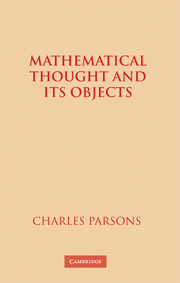7 - Intuitive arithmetic and its limits
Published online by Cambridge University Press: 24 November 2009
Summary
Arithmetic as about strings: Finitism
Although in the last chapter we concluded that natural numbers are not objects of intuition in the sense that was developed in Chapter 5, the system of strings discussed in §28 is still, in some sense, an intuitive model of arithmetic. First, it is a structure of the same similarity type as the natural numbers or the positive integers, consisting of an initial element and a unary operation. Second, it consists of objects of intuition in the sense that there is actual intuition of strings sufficiently early in the sequence and it is possible to draw some conclusions about an arbitrary string intuitively. Third, we can easily satisfy ourselves that it satisfies the Dedekind-Peano axioms. These observations raise the second of the two questions posed at the beginning of Chapter 6: How far does intuitive knowledge in arithmetic extend, when arithmetic is understood with reference to this model of strings? This question was effectively already discussed in the Hilbert school.
In Hilbert's papers on foundations in the 1920s and more fully in Hilbert and Bernays's Grundlagen der Mathematik I of 1934 the method appropriate for metamathematics, what Hilbert called the finitary method, is developed in terms of an interpretation of arithmetic where the objects are strings of just the sort we have been discussing. It is clear from HB I, p. 21, that the authors understand strings (Ziffern) to be the objects of the theory.
- Type
- Chapter
- Information
- Mathematical Thought and its Objects , pp. 235 - 263Publisher: Cambridge University PressPrint publication year: 2007



